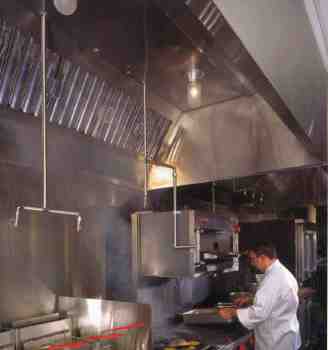| |
 |
|
|
| Commercial Kitchen Ventilation Codes, Standards
|
| |
The 2000 International Mechanical Code
addresses commercial kitchen hood,
exhaust ducts and exhaust equipment in Sections 506
and 507.
Standard for Ventilation Control and Fire Protection
of Commercial Cooking Operations
(NFPA 96) details the minimum fire safety requirements
(preventative and
operative) related to the design, installation, operation,
inspection, and maintenance of
all public and private cooking operations, excluding
single-family residential usage.
These requirements include, but are not limited to,
all manner of cooking equipment,
exhaust hoods, grease-removal devices, exhaust ductwork,
exhaust fans, dampers, fire
extinguishing equipment, and all other auxiliary or
ancillary components or systems
that are involved in the capture, containment, and control
of grease-laden cooking
effluent.
2003 ASHRAE Handbook: HVAC Applications addresses kitchen
ventilation in
Chapter 31. The chapter covers cooking effluent, exhaust
hoods, exhaust systems, replacement
(make-up) air systems, systems integration and balancing,
energy considerations,
fire protection, operation and maintenance and residential
kitchen ventilation.
UL 710 test protocol was established to determine minimum
exhaust rates for 400 F,
600 F, and 700 F (solid fuel) surface temperature appliances.
The air-flow portion of the
test is a visual one made by a U.L. inspector, who observes
the removal of visible
cooking vapors. If, in the judgement of the inspector,
the hood captures and contains
this visible effluent, then the tested exhaust air flow
rate passes the test. What UL 710
does not test for is the amount of heat escaping the
hood at a given air flow. Listed
hoods can have a fire damper to protect ductwork and
maintain temperatures below
375 F or can exist without a fire damper. UL 710 does
not cover evaluation of the
exhaust hoods with respect to their grease extraction
efficiency.
UL 1046 test protocol was established for grease filters
used in exhaust systems with
Type I restaurant type cooking equipment. Grease filters
are investigated to insure they
remove grease from the effluent, drain-off of the collected
grease in such a manner
that it does not fall back on to the cooking surface,
and limit the projection of flames
into the exhaust ductwork when fire breaks out on the
upstream face of the filter and
after exposure to grease-laden air.
UL Subject 762, Power Roof Ventilators for Restaurant
Exhaust Appliances covers
roof or wall-mounted ventilators for restaurant exhaust
appliances. Power ventilators
for restaurant exhaust appliances covered by these requirements
are intended for installation
in accordance with NFPA. |
.gif) |
Common Problems
Some of the most common conditions found in
poorly designed, constructed, and operated
grease exhaust systems:
• Over designed exhaust/make-up
air rates,
leading to energy cost/waste.
• Make-up air
is not sufficient (too little or too
much) to provide proper capture and containment.
• Hoods are not located properly to provide
capture and containment of effluent or drafts exist
from neighboring supply diffusers that impede
capture.
• A short-circuit hood is used causing
spillage.
• Appliances are not grouped according
to
effluent production and the highest effluent
producing appliances are not placed in the center
of the hood system.
• Duct systems are not
liquid tight. The contractor
should perform a pressure test.
• Duct construction
is less than the required 16-
gage steel or 18-gage stainless.
• Improperly
installed or sealed access panels.
• Inaccessible
sections in the ductwork.
• Inadequate clearance
to combustibles.
• Improperly sloped ductwork
and grease
drainage.
• Aluminum mesh filters are used
or no filters at
all.
• Under-powered fans or fans that cannot
be
tipped for cleaning.
• Improperly cleaned
or maintained exhaust
system.
• A proper air balance and system
commissioning
was never performed. |
 |
| |
| |
| |
| |
. |
| Back to Hotels |
| Back to Hvac Expert Main
Page |
|
|
|
|
|
|
|

